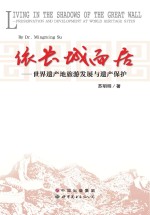

依长城而居 世界遗产地旅游发展与遗产保护PDF格式文档图书下载
- 购买点数:11 点
- 作 者:苏明明著
- 出 版 社:北京/西安:世界图书出版公司
- 出版年份:2013
- ISBN:9787510058813
- 标注页数:272 页
- PDF页数:270 页
Chapter 1 Introduction 1
1.1 An overview 1
1.2 Research Goals and Research Questions 3
Chapter 2 Conceptual Context 4
2.1 Defining Heritage 4
2.1.1Definition of heritage 4
2.1.2 Chinese perspectives on heritage 6
2.1.3 Contestation of heritage 7
2.2 World Heritage Sites 11
2.2.1 Nomination of World Heritage Sites 12
2.2.2 Debate about the concept of World Heritage 13
2.2.3 Impacts of World Heritage on tourism 14
2.3 Relationships between Preservation and Tourism at World Heritage Sites 15
2.4 Important Considerations for Tourism and Preservation atWorld Heritage Sites 18
2.4.1 Stakeholder collaboration 18
2.4.2 Local community participation 19
2.4.3 Coordinating global and local relationships 26
2.5 Chinese Research on World Heritage tourism 28
2.5.1Importance of World Heritage tourism studies in China 28
2.5.2 Research on World Heritage tourism in China 29
2.5.3 Major concerns in tourism and preservation at World Heritage Sites in China 30
2.5.4 Areas to improve in World Heritage research in China 41
2.6 Chapter Summary 42
Chapter 3 The Context of World Heritage in China 44
3.1World Heritage Sites in China 44
3.1.1 World Heritage sites in Beijing 44
3.2 The Great Wall of China 45
3.2.1 Introduction to the Great Wall of China 45
3.2.2 The Great Wall of China as a World Heritage Site 46
3.3 Great Wall Sites in Beijing 49
3.3.1 Geographical features of Great Wall sites in Beijing 49
3.3.2 Tourism development status of Great Wall sites in Beijing 51
3.3.3 Questionnaire survey on Beijing residents 54
3.4 Study Site Selection 61
3.5 Chapter Summary 62
Chapter 4 Research Methodology 63
4.1Study Site 63
4.2 Data Collection Methods 64
4.2.1 Secondary data collection 65
4.2.2 Primary data collection 66
4.3 Methods of Data Analysis 75
4.4 Challenges and Limitations 76
4.5 Chapter Summary 77
Chapter 5 Badaling Great Wall 78
5.1 Badaling Great Wall and its neighborhood 78
5.2 Management structure 81
5.3 Heritage Protection 83
5.4 Tourism Development 85
5.5 Development Plans for Badaling Great Wall 87
5.6 Community participation 91
5.6.1 Small business operators 92
5.6.2 Site employees 101
5.6.3 Comparisons between small business operators and site employees 105
5.7 Chapter Summary 109
Chapter 6 Mutianyu Great Wall 113
6.1 Mutianyu Great Wall and Mutianyu Village 113
6.2 Management structure 114
6.3 Heritage Protection 117
6.4 Tourism Development 119
6.5 Development Plans for Mutianyu Great Wall 120
6.6 Community participation 121
6.6.1 International Residents in the Village 122
6.6.2 Small business operators 125
6.6.3 Mutianyu village residents 131
6.6.4 Site employees 135
6.6.5 Comparative discussion 139
6.7 Chapter Summary 142
Chapter 7 Comparison between Badaling and Mutianyu Great Wall 145
7.1 The Great Wall at Badaling and Mutianyu 145
7.2 Management Structure 146
7.3 Heritage Preservation 147
7.3.1 Current conditions of Great Wall at Badaling and Mutianyu 147
7.3.2 Funding resources 148
7.3.3 Impacts of World Heritage designation on Badaling and Mutianyu 149
7.4 Tourism Development 150
7.4.1 Transportation 150
7.4.2 On-site tourism facilities 150
7.4.3 Tourist numbers and capacities 152
7.4.4 Tourist behaviour 152
7.4.5 Tourism development 155
7.5 Plans for Development 160
7.5.1Important position in district development 160
7.5.2 The expansion trend 161
7.5.3 Collaboration within each Great Wall cluster 161
7.5.4 Local attitudes toward the plans 162
7.6 Local Participation in Heritage Tourism 163
7.6.1 Discussion about local participation 163
7.6.2 Analysis of local participation 166
7.7 Questionnaire Survey at Badaling and Mutianyu 169
7.7.1 Comparison of small tourism business 169
7.7.2 Comparison of opinions of small business operators 171
7.8 Chapter Summary 177
Chapter 8 Discussion 179
8.1Conceptual discussions 179
8.1.1Scales of heritage: global and local 179
8.1.2 Multiple uses of heritage 183
8.2 Empirical implications 186
8.2.1 Stakeholder collaboration in heritage management 186
8.2.2 Local participation in heritage tourism 188
8.2.3 Revisiting plans for their perspectives on the local communities 195
8.3 Chapter Summary 197
Chapter 9 Conclusions 198
9.1 Major Insights 198
9.2 Contributions 200
9.3 Future Research 203
9.4 Concluding Remark 205
Bibliography 207
Appendix Ⅰ 218
Appendix Ⅱ 227
Appendix Ⅲ 239
- 《依长城而居 世界遗产地旅游发展与遗产保护》苏明明著 2013
- 《丝绸之路经济带文化遗产保护与旅游合作发展研究》李树民,王会战主编 2016
- 《旅游与遗产保护 政府治理视角的理论与实证》张朝枝著 2006
- 《促进遗产保护与可持续发展的旅游新理念 善行旅游理论与实践》梁留科主编 2016
- 《乡土文化遗产保护与乡村旅游的可持续发展研究》鲍黎丝,黄明珠,刘红艳著 2019
- 《新疆自然遗产旅游保护性开发研究》刘旭玲著 2014
- 《农业文化遗产旅游开发与保护研究》熊礼明著 2017
- 《遗产旅游发展与管理》邹统钎等著 2010
- 《中国农村工业遗产保护与旅游利用研究》王慧著 2014
- 《农业文化遗产地旅游发展潜力研究》孙业红著 2011
- 《IMI消费行为与生活形态年鉴 北京·上海·广州·重庆·武汉·西安 1998-1999 下》IMI(创研)市场信息研究所等编 1998
- 《IMI消费行为与生活形态年鉴 北京·上海·广州·重庆·武汉·西安 1998-1999 上》IMI(创研)市场信息研究所等编 1998
- 《IMI消费行为与生活形态年鉴 2005-2006 北京·上海·广州·深圳·成都·重庆·武汉·西安·沈阳·南京 上》黄升民主编;IMI(创研)市场信息研究所等编 2005
- 《老北京记忆》刘啸编著 2017
- 《THE GOVERNMENT/PRESS CONNECTION PRESS OFFICERS AND THEIR OFFICES》STEPHEN HESS 1984
- 《秦封泥汇考》傅嘉仪编著 2007
- 《朱门 最新修订精装典藏版》林语堂著 2012
- 《PRESS》POLITICS & PUBLIC OPINION IN BIHAR 1912-1947 2010
- 《Press law》Robin Callender Smith. 1978
- 《SUING THE PRESS》RODNEY A.SMOLLA 1986
